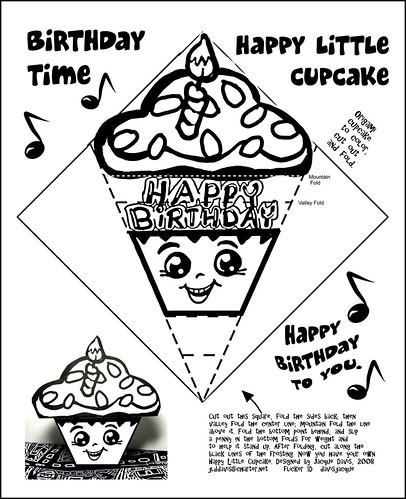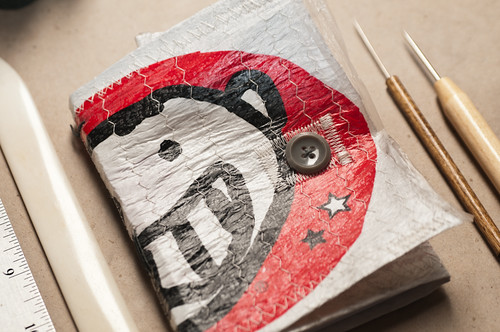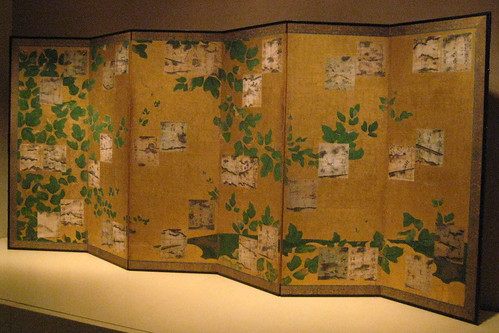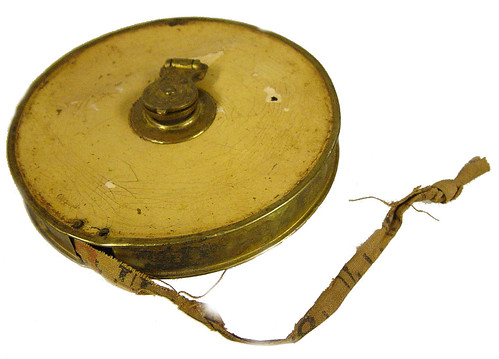Happy Little Cupcake Birthday -to color
Image by davis.jacque
For more "happy little cupcake" origami paper and instructions on how to fold, see my flickr photostream.
I have marked the copy right on this photo for free use, to be used as a coloring and origami page for anyone who likes it.
Custom Upcycled Newbury Comics Journal
Image by Krissy and Dennis
(Newbury Comics) Small Sized Upcycled Journal
- Size is approximately 4.5" x 6.75" (116mm x 171mm)
- Five Signatures, 100 pages
- Cover is made of fused layers of plastic, with the cover being white and red, made from a Newbury Comics bag, sewn over with white thread.
- Binding: Combination long stitch and chain stitch bound with black waxed Irish linen thread.
This is a small-sized journal or notebook filled with lined paper. The book is held shut with a flap that folds over the text block and buttons through the cover.
This particular book uses black Irish linen thread, which is my personal favorite type of thread to use as it's much stronger and far less prone to snagging while maintaining a natural aesthetic. The button is tan/khaki, giving this book a more neutral, almost masculine feel.
The text block consists of 100 pages (total) of lined paper, suitable for keeping a journal, writing notes, keeping appointments, or just about anything else
The cover is water-resistant, as it is made of plastic, so water will bead off of it. However, there are holes made from sewing through the cover, so I wouldn't use it as a substitute umbrella or anything.
If you like the concept, but not this particular design, feel free to contact us. We can make almost any type of book using most any plastic (so long as it's on the thinner side). If you have a particular brand's plastic bag that you like, we'd be more than happy to use that as a cover as well. We love creating custom books for people, so feel free to contact us to collaborate on a project!
Find us on Etsy here:
kleinereisbar.etsy.com/
Facebook:
www.facebook.com/KleinerEisbar
Tumblr:
kleinereisbar.tumblr.com/
Photo by Dennis
Painting of Arrowroot Vines with Thirty-six Poems Quoted from Wakan rōeishū
Image by wallyg
Painting of Arrowroot Vines with Thirty-six Poems Quoted from Wakan rōeishū (Anthology of Japanese and Chinese Poems)
Painting Attributed to Hasegawa Sōya (1590-)
Calligraphy Attributed to Konoe Nobuhiro (1599-1649)
Edo Period (1615-1868), early 17th century
Six-fold screen, nk and color on gilded paper
Thirty-six poem cards; ink, color, gold, and silver on paper
Gracefully swaying arrowroot vines depicted here in autumnal decline were a popular subject for paintings on screens, especially when decorated with poem cards (shikishi), as in this case. Adhering to the ancient East Asian axium that poetry, calligraphy and painting are inseparable and equal, the Japanese since the ninth century decorated screens with paintings and poems, which were inscribed in fine calligraphy.
A screen that closely resembles this pieces, also representing arrowroot vines, is signed b Hasegawa Sōya, son of the leading sixteenth-century painter Hasegawa Tōhaku (1539-1610). It includes a crescent moon, suggesting that this screen too was once paired with a companion piece depicting the moon.
Three pairs of shikishi are pasted on each panel of the screeen; each pair is inscribed with a poem in Chinese at the right and a waka (thirty-one syllable Japanese-style poem) at the left. The poems in Chinese and Japanese share common themes, such as the four seasons, bamboo, pines, or clouds. The idiosyncratic style of calligraphy, with hooks at the end of strokes and the tall, elongated profile of the characters, is attributable to nobleman calligrapher Konoe Nobuhiro.
Purchase, several members of the Chairman's Council Gifts, 2001 (2001.423)
**
The Metropolitan Museum of Art's permanent collection contains more than two million works of art from around the world. It opened its doors on February 20, 1872, housed in a building located at 681 Fifth Avenue in New York City. Under their guidance of John Taylor Johnston and George Palmer Putnam, the Met's holdings, initially consisting of a Roman stone sarcophagus and 174 mostly European paintings, quickly outgrew the available space. In 1873, occasioned by the Met's purchase of the Cesnola Collection of Cypriot antiquities, the museum decamped from Fifth Avenue and took up residence at the Douglas Mansion on West 14th Street. However, these new accommodations were temporary; after negotiations with the city of New York, the Met acquired land on the east side of Central Park, where it built its permanent home, a red-brick Gothic Revival stone "mausoleum" designed by American architects Calvert Vaux and Jacob Wrey Mold. As of 2006, the Met measures almost a quarter mile long and occupies more than two million square feet, more than 20 times the size of the original 1880 building.
In 2007, the Metropolitan Museum of Art was ranked #17 on the AIA 150 America's Favorite Architecture list.
The Metropolitan Museum of Art was designated a landmark by the New York City Landmarks Preservation Commission in 1967. The interior was designated in 1977.
National Historic Register #86003556
Katie with Flower Scribbles
Image by mahalie
This is the photo I attached on the inside of thank you cards after Katie's funeral. It's a more recent (my favorite) shot of her.
How To Extract A Pattern and Create a Custom Photo Frame
To create this effect I scanned the photo and pulled it into Photoshop. Ran autolevels (I almost always do this to every photo - Image > Adjust > Autolevels), touched up scratches with the stamp tool and then applied a 'spotlight' lighting filter (under Filters > Renter > Lighting Effects). See original photo at this stage.
Next, I opened a high resolution scan of the notecard I was putting the photo in and did a color selection to get all the yellow pattern. After zooming way in and correcting the selection area, especially around the fold area and removing things I didn't want (using the lasso tool, hit + to add selection and - to subtract), still in that image, I created a new layer and just filled the selection with white.
I copied the white layer and then went back to my photo of katie and pasted it. This creates a new layer automatically. The image was far too large so I hit CNTRL+T to transform and hold the shift key down while manually shrinking the overlay to prevent stretching it. Once satisfied I hit enter. Note you could do this several times, rotate the patter, cut some out, paste different aspects of it on new layers, etc.
After I was done futsing with the pattern overlay I flattened just the pattern related layers and added a mask. On the mask I selected the area of Katies face using the oval marquee select tool, inverted the selection (Select > Invert) and feathered the selection (Select > feather) quite a bit (in this case, 20 pixels), then I hit delete, which essentially removed any pattern overlay obfuscating her face. Still on the mask layer I grabbed the paint tool (in black) which is essentially like erasing what shows on the pattern layer, and manually touched up areas I thought were too busy. Finally I changed the layer to Hard Light and took the opacity down a bit to make the pattern blend into the photo.
This is a nice effect and quick to do once you've gone throught the process a few times. A great way to make matching stationary or invitations or create a nice graphics for your website to match an invite or letterhead or something.
Note, there's other ways to do this, like making the original pattern selection a path and exporting to Illustrator. That's a great trick, but I'll cover it later.
If there's interest, I could go into more detail and/or take some time and post step by step shots. Just let me know...
29362 Grand Canyon National Park: 1893 Miner's Measuring Tape
Image by Grand Canyon NPS
CIRCULAR MEASURING TAPE WITH A BRASS EXTERIOR RIM WHICH HOLDS TWO CIRCULAR PIECES OF CREAM COLORED CARD (PAINT IS CRACKED & FLAKING). IN THE CENTER IS A BRASS WASHER & FOLDED TURNING KNOB WITH "75 FT" STAMPED ON IT. THE OTHER SIDE HAS TWO BRASS WASHERS, ONE IS LOOSE. THERE IS A 1 CM OPENING IN THE BRASS EXTERIOR RIM WHERE THE CLOTH MEASURING TAPE PROTRUDES. VISIBLE IS ONE OF THE BRASS ROLLERS TO HOLD THE TAPE FLAT. ONE IS MISSING. THE TAPE IS A BROWN COLOR WITH BLACK NUMBERS PRINTED ON IT..
.
THIS ITEM WAS PART OF A 1893 MINER'S CACHE, STORED IN A LARGE SQUARE TIN AND LOCATED IN THE SUPAI AREA. SOME OF THE ITEMS FROM THIS CACHE ARE ON EXHIBIT AT THE GRAND CANYON VISITOR CENTER. (SOUTH RIM).
.
THE CACHE INCLUDED VARIOUS PROVISIONS,TOILETRIES AND SUNDRIES (CATALOG #'S 29237- 29243, 29255- 29259, 29287- 29288, 29303- 29304, 29345- 29347, 29362- 29370) AND A NOTEBOOK WITH A MESSAGE ON THE FIRST PAGE THAT READS: .
"THIS CASH (SIC) WAS MADE BY/ I.(?) C. REES. ON THE 5TH DAY/ OF JANRURURY (SIC) 1893 IF YOU/ NEED ANY THING IN IT TO/ USE TAKE IT AND WELCOME BUT DO NOT DESTROY OR WASTE/ OR WASTE ANY THING AND YOU/ WILL OBLIDGE (SIC). I.(?) C. REES.. www.flickr.com/photos/grand_canyon_nps/6883823216/
.
Grand Canyon National Park Musuem Collection, P.O. Box 129, Grand Canyon, AZ 86023
No comments:
Post a Comment